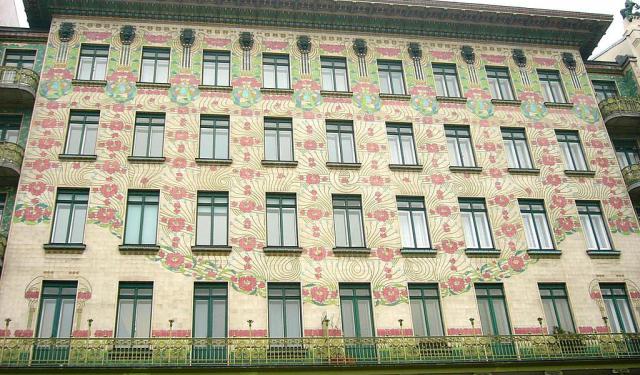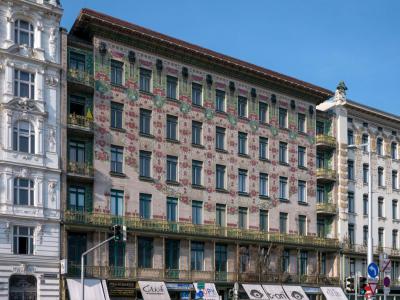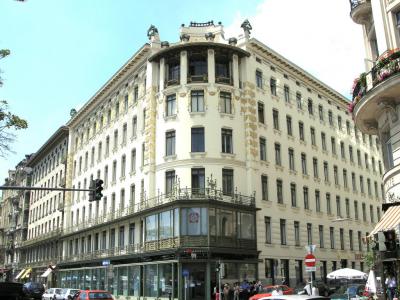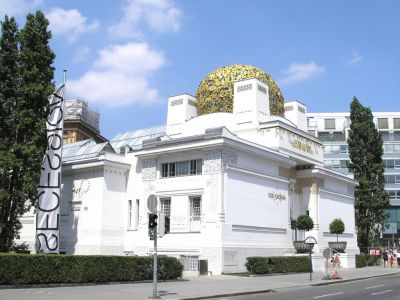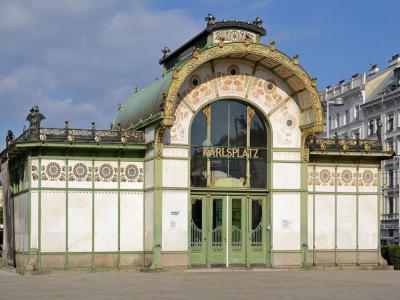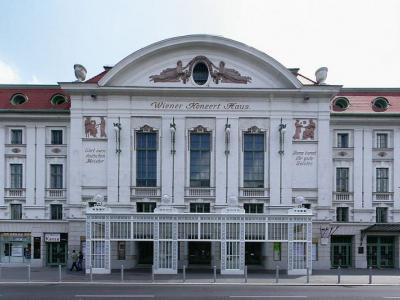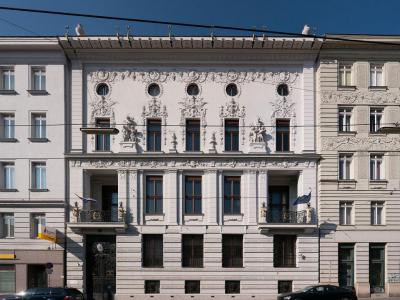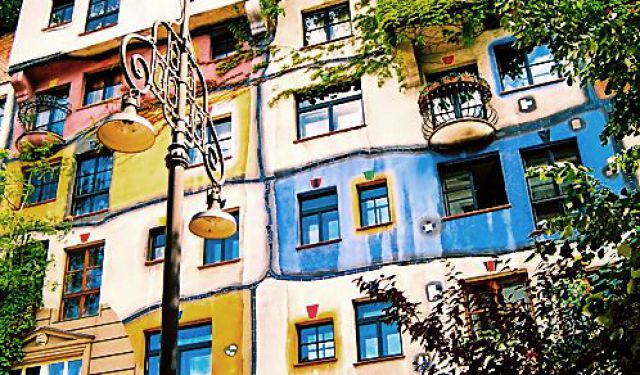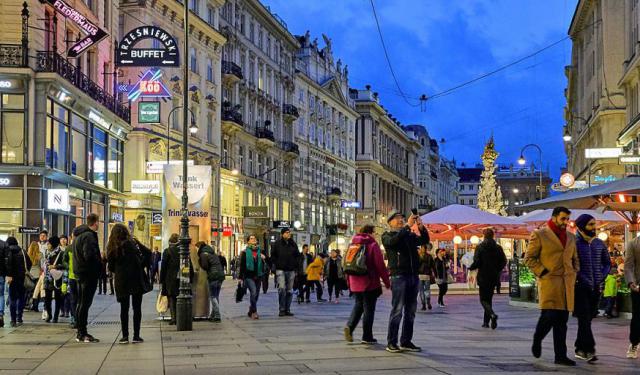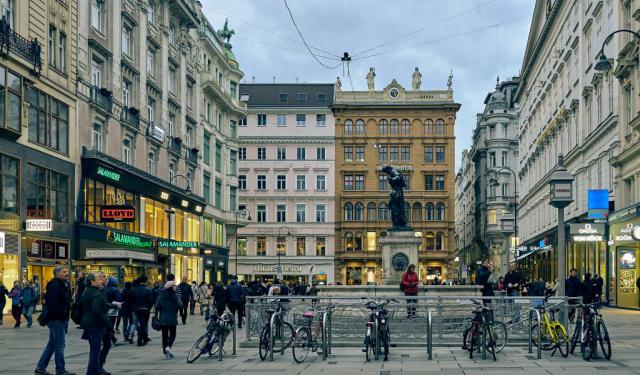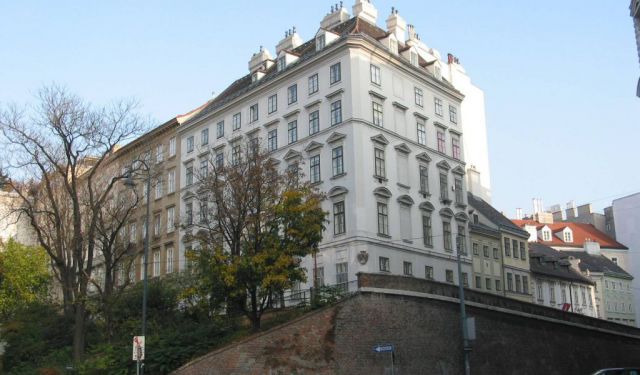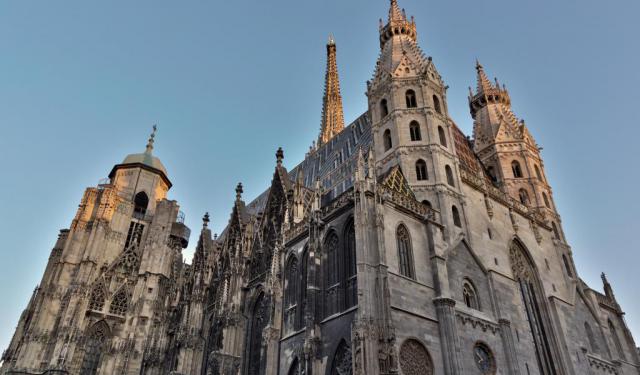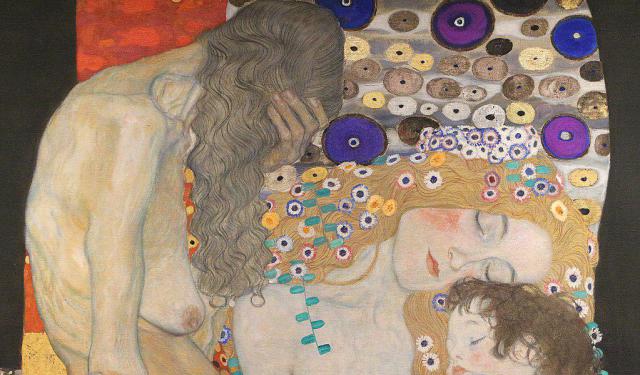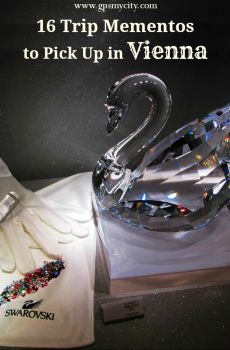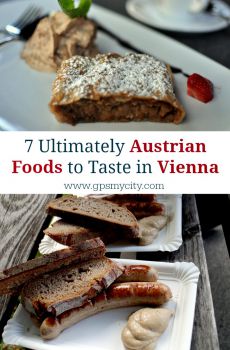Audio Guide: Vienna's Art Nouveau Architecture Tour II (Self Guided), Vienna
If there are cities that flirt, Vienna is definitely the one. Here, even the buildings know how to do it.
Around the turn of the 20th century, the Austrian capital caught the Art Nouveau fever and decided that straight lines, drab walls, and historical imitation simply wouldn’t do anymore. Instead, it took to ornamental swirls, flowing curves, floral flourishes, and enough decorative detail to make a Baroque angel blush. The goal was to create a “total work of art” where architecture, furniture, door handles, and even the tiniest curtain tassels all conspired to whisper the same aesthetic message.
At the heart of this elegant rebellion stood Otto Wagner-the architect, urban planner, furniture whisperer, and all-around design guru. Wagner believed that beauty must serve a purpose, famously declaring, “Anything impractical cannot be beautiful.” Clearly, he never met a sequin, but the man had a point.
His creations include the Medallion House, decked out in-you guessed it-gold medallions; the Majolica House, with a facade so flowery it could double as a bouquet; and the Karlsplatz Stadtbahn Station, where wrought iron curves and glass panels seem to dance. And let’s not forget Hoyos Palace, a dreamy mash-up of Art Nouveau and neo-Baroque that looks like it was designed for a particularly stylish duchess.
But Wagner wasn’t the only one shaking things up. Check out the Secession Building, designed by Joseph Maria Olbrich-a temple to artistic freedom crowned with a giant golden cabbage (sorry, dome). And then there’s the Vienna Concert Hall, where music and architecture hold hands and waltz into eternity.
Each stop on the second part of the Art Nouveau tour of Vienna (yes, two parts-you surely didn’t expect us to fit all that glamour into one, did you?) offers a new story, a different flourish, another decorative wink. Together, they prove that Vienna didn’t just flirt with Art Nouveau-it went all in, lit the candle, and poured the wine.
So, don't take your comfy shoes off just yet, but bring your most appreciative sigh, and prepare to step into a city where fantasy hugs the façade, and beauty is always in the details...
Around the turn of the 20th century, the Austrian capital caught the Art Nouveau fever and decided that straight lines, drab walls, and historical imitation simply wouldn’t do anymore. Instead, it took to ornamental swirls, flowing curves, floral flourishes, and enough decorative detail to make a Baroque angel blush. The goal was to create a “total work of art” where architecture, furniture, door handles, and even the tiniest curtain tassels all conspired to whisper the same aesthetic message.
At the heart of this elegant rebellion stood Otto Wagner-the architect, urban planner, furniture whisperer, and all-around design guru. Wagner believed that beauty must serve a purpose, famously declaring, “Anything impractical cannot be beautiful.” Clearly, he never met a sequin, but the man had a point.
His creations include the Medallion House, decked out in-you guessed it-gold medallions; the Majolica House, with a facade so flowery it could double as a bouquet; and the Karlsplatz Stadtbahn Station, where wrought iron curves and glass panels seem to dance. And let’s not forget Hoyos Palace, a dreamy mash-up of Art Nouveau and neo-Baroque that looks like it was designed for a particularly stylish duchess.
But Wagner wasn’t the only one shaking things up. Check out the Secession Building, designed by Joseph Maria Olbrich-a temple to artistic freedom crowned with a giant golden cabbage (sorry, dome). And then there’s the Vienna Concert Hall, where music and architecture hold hands and waltz into eternity.
Each stop on the second part of the Art Nouveau tour of Vienna (yes, two parts-you surely didn’t expect us to fit all that glamour into one, did you?) offers a new story, a different flourish, another decorative wink. Together, they prove that Vienna didn’t just flirt with Art Nouveau-it went all in, lit the candle, and poured the wine.
So, don't take your comfy shoes off just yet, but bring your most appreciative sigh, and prepare to step into a city where fantasy hugs the façade, and beauty is always in the details...
How it works: Download the app "GPSmyCity: Walks in 1K+ Cities" from Apple App Store or Google Play Store to your mobile phone or tablet. The app turns your mobile device into a personal tour guide and its built-in GPS navigation functions guide you from one tour stop to next. The app works offline, so no data plan is needed when traveling abroad.
Vienna's Art Nouveau Architecture Tour II Map
Guide Name: Vienna's Art Nouveau Architecture Tour II
Guide Location: Austria » Vienna (See other walking tours in Vienna)
Guide Type: Self-guided Walking Tour (Sightseeing)
# of Attractions: 6
Tour Duration: 1 Hour(s)
Travel Distance: 2.0 Km or 1.2 Miles
Author: leticia
Sight(s) Featured in This Guide:
Guide Location: Austria » Vienna (See other walking tours in Vienna)
Guide Type: Self-guided Walking Tour (Sightseeing)
# of Attractions: 6
Tour Duration: 1 Hour(s)
Travel Distance: 2.0 Km or 1.2 Miles
Author: leticia
Sight(s) Featured in This Guide:
- Majolika-Haus (Majolica House)
- Medallion House
- Secessionsgebaude (Secession Building)
- Karlsplatz Stadtbahn Station
- Wiener Konzerthaus (Vienna Concert Hall)
- Palais Hoyos (Hoyos Palace)
1) Majolika-Haus (Majolica House)
Majolica House is one of those rare spots in Vienna (and probably further afield, too) where you can see flowers bloom not in the garden, but across the façade. This eye-catching beauty is the work of Otto Wagner, Vienna’s poster boy for the Secessionist movement. During his “I’m done with Baroque” phase, Wagner decided to ditch the frills and go full-on floral with clean lines and tiled elegance. The building’s name comes from its ceramic tiles, dripping with pinks, greens, and blues in swirling botanical glory. Think wallpaper for the outside walls, only waterproof and wildly photogenic.
Wagner’s architectural rebellion was all about simplicity with flair. No ornate carvings, no dramatic cornices-just smooth surfaces and windows that mind their own business. The outside hinted at the inside: clean, modern, functional. Still rectangular, sure, but very much a rebel in a world of curvy cupolas and frilly stonework. Today, it’s still considered a top-tier Art Nouveau masterpiece, minus the ego...
Not far off is House No. 38, where Wagner teamed up with fellow art renegades. You’ll spot Koloman Moser’s bold reliefs and Othmar Schimkowitz’s gilded stucco medallions catching sunlight like they know they're fabulous. Then there’s a more modest building at No. 3 Köstlergasse-rumored to be Wagner’s own residence. Understated, of course, because nothing says “architect’s ego” like hiding in plain sight.
And when you’re ready to change levels-literally-head down into Kettenbrückengasse subway station, also a Wagner design. It’s where style meets utility with such grace, you might forget you’re just waiting for a train.
Now, onward-Vienna doesn’t admire itself...
Pro tip:
Go on a bright day, and bring binoculars. Seriously. The details tucked under balconies and along the eaves are worth the squint. Wagner wasn’t just designing buildings-he was composing symphonies in ceramic and stucco.
Wagner’s architectural rebellion was all about simplicity with flair. No ornate carvings, no dramatic cornices-just smooth surfaces and windows that mind their own business. The outside hinted at the inside: clean, modern, functional. Still rectangular, sure, but very much a rebel in a world of curvy cupolas and frilly stonework. Today, it’s still considered a top-tier Art Nouveau masterpiece, minus the ego...
Not far off is House No. 38, where Wagner teamed up with fellow art renegades. You’ll spot Koloman Moser’s bold reliefs and Othmar Schimkowitz’s gilded stucco medallions catching sunlight like they know they're fabulous. Then there’s a more modest building at No. 3 Köstlergasse-rumored to be Wagner’s own residence. Understated, of course, because nothing says “architect’s ego” like hiding in plain sight.
And when you’re ready to change levels-literally-head down into Kettenbrückengasse subway station, also a Wagner design. It’s where style meets utility with such grace, you might forget you’re just waiting for a train.
Now, onward-Vienna doesn’t admire itself...
Pro tip:
Go on a bright day, and bring binoculars. Seriously. The details tucked under balconies and along the eaves are worth the squint. Wagner wasn’t just designing buildings-he was composing symphonies in ceramic and stucco.
2) Medallion House
The shimmering show-off known as the Medallion House is a golden gem in Vienna’s Secessionist crown. Designed by none other than Otto Wagner and completed in 1899, this apartment block stands shoulder to shoulder with its equally flamboyant sibling, the Majolica House, in a dazzling display of architectural one-upmanship.
Why “Medallion House”? Because of the bling, of course. The name comes from the gilded stucco medallions designed by Wagner’s protégé and frequent partner-in-aesthetic-crime, Koloman Moser. Unlike Majolica’s garden-party palette of pinks, blues, and greens, the Medallion House prefers to go full glam-gold rules the façade, and not just the front. Since the building is on a corner, Moser didn’t stop there-he decked out the entire length like it was going to a fashion gala.
The medallions feature serene, statuesque women flanked by palm leaves and floral swirls, a cocktail of classical inspiration and Art Nouveau flair. And if that wasn’t theatrical enough, look up. Higher... There, atop the roof, you’ll find "The Criers" (or "The Crying Women" if you like), sculpted by Othmar Schimkowitz, who was no stranger to dramatic rooftops-he also did the angels for Otto Wagner’s Postal Savings Bank. These windswept figures seem to wail into the skyline, giving the whole building a kind of high-stakes opera vibe.
Wagner had big dreams for this stretch of the street-urban housing with style, edge, and plenty of Instagram appeal, a century before filters were a thing. In 1914, the Medallion House became the property of the Kohn family. But during World War II, the building was seized after the family was forced into exile. Justice prevailed in 1947, when the Kohns successfully reclaimed their home.
Today, the Medallion House doesn’t just star on postcards-it graces an actual €100 gold coin. And in true Viennese fashion, it currently houses... a bank. Because nothing says “austere financial institution” quite like a façade dripping in gold and silent drama queens on the roof.
So, next time you're wandering the Naschmarkt side of town, look up. The Medallion House doesn’t just whisper history-it practically sings it from the rooftops.
Why “Medallion House”? Because of the bling, of course. The name comes from the gilded stucco medallions designed by Wagner’s protégé and frequent partner-in-aesthetic-crime, Koloman Moser. Unlike Majolica’s garden-party palette of pinks, blues, and greens, the Medallion House prefers to go full glam-gold rules the façade, and not just the front. Since the building is on a corner, Moser didn’t stop there-he decked out the entire length like it was going to a fashion gala.
The medallions feature serene, statuesque women flanked by palm leaves and floral swirls, a cocktail of classical inspiration and Art Nouveau flair. And if that wasn’t theatrical enough, look up. Higher... There, atop the roof, you’ll find "The Criers" (or "The Crying Women" if you like), sculpted by Othmar Schimkowitz, who was no stranger to dramatic rooftops-he also did the angels for Otto Wagner’s Postal Savings Bank. These windswept figures seem to wail into the skyline, giving the whole building a kind of high-stakes opera vibe.
Wagner had big dreams for this stretch of the street-urban housing with style, edge, and plenty of Instagram appeal, a century before filters were a thing. In 1914, the Medallion House became the property of the Kohn family. But during World War II, the building was seized after the family was forced into exile. Justice prevailed in 1947, when the Kohns successfully reclaimed their home.
Today, the Medallion House doesn’t just star on postcards-it graces an actual €100 gold coin. And in true Viennese fashion, it currently houses... a bank. Because nothing says “austere financial institution” quite like a façade dripping in gold and silent drama queens on the roof.
So, next time you're wandering the Naschmarkt side of town, look up. The Medallion House doesn’t just whisper history-it practically sings it from the rooftops.
3) Secessionsgebaude (Secession Building)
Welcome to the rebellious heart of early 20th-century Vienna-where artists weren’t merely painting outside the lines, they were redrawing the canvas entirely. This is the Secession Building, a shimmering shout of defiance against artistic convention, and the architectural embodiment of the Secessionist movement’s famous motto: "To every age its art. To every art its freedom."
Designed by Joseph Olbrich in 1898, this building doesn’t just house art-it is art. From the gold-leafed laurel dome (which the locals affectionately nicknamed “the golden cabbage”-made up of 2,500 gilt laurel leaves and 300+ berries) to the stone turtles balancing enormous planters by the doors, the structure is a bold, symbolic nod to ancient triumph and an unapologetic flex for modernity. Olbrich imagined a dome of laurel; Vienna saw a salad. Art is nothing without interpretation, after all...
Now, here’s the main course-Gustav Klimt’s Beethoven Frieze, painted in 1902 as a tribute to Beethoven’s Ninth Symphony. It wraps around the interior like a mythological fever dream-knights, maidens, monsters, longing, redemption-all rendered in Klimt’s shimmering, sinuous style. It’s the only painting inside, and trust us, that’s all you’ll need.
The interior is purposefully minimalist. No distractions. Just you, the art, and the low hum of quiet admiration. It's one of those rare museum experiences where you’re actually encouraged to pause, breathe, and let the space do its thing. Also, yes-you can take photos (no need to sneak one with your phone pressed to your thigh).
If you’re a Klimt enthusiast or just curious about what happens when art stages a revolution, this is your temple. The façade alone stops traffic-literally, tourists cross busy Vienna streets just to snap a shot.
Pro tip:
Grab the audio guide (available in German, English, French, and even Italian). It lets you sit, stare, and soak in each detail without juggling pamphlets or squinting at wall text. Art rebellion has never sounded so smooth.
Designed by Joseph Olbrich in 1898, this building doesn’t just house art-it is art. From the gold-leafed laurel dome (which the locals affectionately nicknamed “the golden cabbage”-made up of 2,500 gilt laurel leaves and 300+ berries) to the stone turtles balancing enormous planters by the doors, the structure is a bold, symbolic nod to ancient triumph and an unapologetic flex for modernity. Olbrich imagined a dome of laurel; Vienna saw a salad. Art is nothing without interpretation, after all...
Now, here’s the main course-Gustav Klimt’s Beethoven Frieze, painted in 1902 as a tribute to Beethoven’s Ninth Symphony. It wraps around the interior like a mythological fever dream-knights, maidens, monsters, longing, redemption-all rendered in Klimt’s shimmering, sinuous style. It’s the only painting inside, and trust us, that’s all you’ll need.
The interior is purposefully minimalist. No distractions. Just you, the art, and the low hum of quiet admiration. It's one of those rare museum experiences where you’re actually encouraged to pause, breathe, and let the space do its thing. Also, yes-you can take photos (no need to sneak one with your phone pressed to your thigh).
If you’re a Klimt enthusiast or just curious about what happens when art stages a revolution, this is your temple. The façade alone stops traffic-literally, tourists cross busy Vienna streets just to snap a shot.
Pro tip:
Grab the audio guide (available in German, English, French, and even Italian). It lets you sit, stare, and soak in each detail without juggling pamphlets or squinting at wall text. Art rebellion has never sounded so smooth.
4) Karlsplatz Stadtbahn Station
Otto Wagner-Vienna’s own king of curves and crown prince of steel... When he took charge of the city’s underground system in the 1890s, he didn’t just design train stations-he gave the Viennese public transit a full-blown Art Nouveau glow-up. Enter the twin Karl's Square pavilions, those photogenic little buildings that look like they belong in an opera about trains falling in love...
With their swirling floral motifs, sleek lines, and unapologetically exposed steel framework (because Wagner believed architecture shouldn’t lie), these beauties are equal parts sculpture and structure. They opened to the public in 1899 and promptly became the city’s most stylish way to exit a railway platform.
Fast-forward to the 1980s. The city’s old Stadtbahn line was being updated to the modern U-Bahn, and some genius had the bright idea to demolish Wagner’s pavilions. The Viennese public responded with a collective “absolutely not,” and a full-on preservation revolt followed. As a result, the pavilions were disassembled piece by ornate piece, hoisted up about seven feet, and then reassembled like architectural Lego-Viennese edition.
Today, the twin structures face each other across Karl's Square like two stylish old ladies trading secrets. One is now a delightfully eccentric café (no word on whether the ghost of Wagner sips espresso there); and the other houses a compact exhibit on his life’s work, including a striking model of his magnum opus, the Church at Steinhof.
Local tip:
While you're around Karl's Square, don’t miss Saint Karl's Church, an overachieving Baroque masterpiece with a dome that practically shouts, “Behold me!” You’ll also find the University of Technology, the Vienna City Museum, and the delightfully rebellious Secession Building, famous for its golden cabbage-shaped dome and complete lack of subtlety. And if it's summer, grab a bench under the trees in Resselpark, and let Vienna do the storytelling for you.
With their swirling floral motifs, sleek lines, and unapologetically exposed steel framework (because Wagner believed architecture shouldn’t lie), these beauties are equal parts sculpture and structure. They opened to the public in 1899 and promptly became the city’s most stylish way to exit a railway platform.
Fast-forward to the 1980s. The city’s old Stadtbahn line was being updated to the modern U-Bahn, and some genius had the bright idea to demolish Wagner’s pavilions. The Viennese public responded with a collective “absolutely not,” and a full-on preservation revolt followed. As a result, the pavilions were disassembled piece by ornate piece, hoisted up about seven feet, and then reassembled like architectural Lego-Viennese edition.
Today, the twin structures face each other across Karl's Square like two stylish old ladies trading secrets. One is now a delightfully eccentric café (no word on whether the ghost of Wagner sips espresso there); and the other houses a compact exhibit on his life’s work, including a striking model of his magnum opus, the Church at Steinhof.
Local tip:
While you're around Karl's Square, don’t miss Saint Karl's Church, an overachieving Baroque masterpiece with a dome that practically shouts, “Behold me!” You’ll also find the University of Technology, the Vienna City Museum, and the delightfully rebellious Secession Building, famous for its golden cabbage-shaped dome and complete lack of subtlety. And if it's summer, grab a bench under the trees in Resselpark, and let Vienna do the storytelling for you.
5) Wiener Konzerthaus (Vienna Concert Hall)
Coming in just behind the mighty Musikverein and its glitzy Golden Hall, Vienna Concert Hall is no mere understudy. This is the grand stage for the Vienna Symphony Orchestra, a trio of concert halls, the Academy Theatre, and even a studio theatre-because why stop at one spotlight when you can have five?
Opened in 1913, the building is a late Secessionist beauty crafted by Austria’s theater dream team, Fellner & Helmer. Outside, a glowing wrought-iron-and-glass canopy (yes, illuminated) welcomes you in style, topped off with octagons and a charming half-moon gable-because nothing says “evening of culture” like celestial geometry...
Inside, you’ve got options: the Great Hall for the grand and glorious, the Mozart Hall for the intimate and intricate, the Schubert Hall for that poetic melancholy, and the sleek Berio Hall if you're feeling a bit avant-garde. Four shows can go on all at once here, so don’t be surprised if you hear a string quartet on your left and world music on your right.
Musically speaking, the Concert Hall keeps things spicy. While the Musikverein sticks to its classical guns, the Concert Hall flirts with jazz, cabaret, world music, and the occasional brush with pop. It's the venue that wears a tuxedo, but might as well show up in training shoes.
Acoustics? Pristine. Seating? Surprisingly comfy-no need to endure 90 minutes of symphony with your knees wedged into your chest. Whether you’re here in January or July, something magical will be playing, echoing through halls that make you feel like the music is just for you.
In short: come for the concert, stay for the architectural flirtation, and leave with your ears (and knees) well taken care of.
Opened in 1913, the building is a late Secessionist beauty crafted by Austria’s theater dream team, Fellner & Helmer. Outside, a glowing wrought-iron-and-glass canopy (yes, illuminated) welcomes you in style, topped off with octagons and a charming half-moon gable-because nothing says “evening of culture” like celestial geometry...
Inside, you’ve got options: the Great Hall for the grand and glorious, the Mozart Hall for the intimate and intricate, the Schubert Hall for that poetic melancholy, and the sleek Berio Hall if you're feeling a bit avant-garde. Four shows can go on all at once here, so don’t be surprised if you hear a string quartet on your left and world music on your right.
Musically speaking, the Concert Hall keeps things spicy. While the Musikverein sticks to its classical guns, the Concert Hall flirts with jazz, cabaret, world music, and the occasional brush with pop. It's the venue that wears a tuxedo, but might as well show up in training shoes.
Acoustics? Pristine. Seating? Surprisingly comfy-no need to endure 90 minutes of symphony with your knees wedged into your chest. Whether you’re here in January or July, something magical will be playing, echoing through halls that make you feel like the music is just for you.
In short: come for the concert, stay for the architectural flirtation, and leave with your ears (and knees) well taken care of.
6) Palais Hoyos (Hoyos Palace)
When Otto Wagner decided to build himself a “town house” at Rennweg No. 3 during the 1890s, let’s just say he wasn’t slumming it. Today we know it as the Hoyos Palace, home to the Croatian embassy, but back then it was a flashy statement in high Ringstrasse style. Think lavish wrought-iron balconies, theatrical stucco flourishes, and just a dash of that future-modern flair Wagner would later be known for-like the bold cornice and those elegant upper-floor reliefs that quietly whisper, “Secession is coming…”
Wagner, ever the architectural multitasker, also designed the neighbors, including No. 5 next door. That one gained a bit of fame of its own-this is where composer Gustav Mahler resided from 1898 to 1909. One can only imagine the heated creative debates drifting through the walls-architecture meets music, with coffee breaks in between...
Just a few steps away along Rennweg, you’ll find the Guards' Church-a temple with an identity crisis. Originally built in the 1760s by Nicolò Pacassi (the court architect to Empress Maria Theresa herself), it was given a Neoclassical facelift only six years later. Classic midlife glow-up... But walk inside and you’re back in full Rococo glory: gold-dripping stuccowork, a ribbed dome, lantern-lit drama, and those delightful bull’s-eye windows watching over it all.
Once the chapel for the imperial hospital, it was handed over in 1782 to the Polish Guards, who made it their spiritual home. These days, it still hosts services in Polish and goes by the charming nickname “Polish Church.” Because nothing says “Vienna” like Baroque architecture with a Slavic soul.
Wagner, ever the architectural multitasker, also designed the neighbors, including No. 5 next door. That one gained a bit of fame of its own-this is where composer Gustav Mahler resided from 1898 to 1909. One can only imagine the heated creative debates drifting through the walls-architecture meets music, with coffee breaks in between...
Just a few steps away along Rennweg, you’ll find the Guards' Church-a temple with an identity crisis. Originally built in the 1760s by Nicolò Pacassi (the court architect to Empress Maria Theresa herself), it was given a Neoclassical facelift only six years later. Classic midlife glow-up... But walk inside and you’re back in full Rococo glory: gold-dripping stuccowork, a ribbed dome, lantern-lit drama, and those delightful bull’s-eye windows watching over it all.
Once the chapel for the imperial hospital, it was handed over in 1782 to the Polish Guards, who made it their spiritual home. These days, it still hosts services in Polish and goes by the charming nickname “Polish Church.” Because nothing says “Vienna” like Baroque architecture with a Slavic soul.
Walking Tours in Vienna, Austria
Create Your Own Walk in Vienna
Creating your own self-guided walk in Vienna is easy and fun. Choose the city attractions that you want to see and a walk route map will be created just for you. You can even set your hotel as the start point of the walk.
Vienna's Art Nouveau Architecture Tour I
Vienna’s flirtation with Art Nouveau-known locally as Jugendstil-unfolded in the late 19th, early 20th centuries. The so-called Vienna Secession movement, which emerged in 1897, was led by a group of rebellious artists and architects like Otto Wagner, Gustav Klimt, and Koloman Moser, who turned their backs on historicism in favor of bold, modern aesthetics. As the new language for buildings,... view more
Tour Duration: 2 Hour(s)
Travel Distance: 3.4 Km or 2.1 Miles
Tour Duration: 2 Hour(s)
Travel Distance: 3.4 Km or 2.1 Miles
Vienna Introduction Walking Tour
A city of green parks, opulent architecture, elegant shopping, crowded theaters, and boulevards for leisurely sauntering - Vienna, the capital of Austria, embodies a blend of regal tradition and contemporary vibrancy. The origin of the city's name is rooted in Roman times, stemming from the Celtic word Vedunia, meaning “forest stream”, which later evolved into Vindobona, a Roman... view more
Tour Duration: 3 Hour(s)
Travel Distance: 4.6 Km or 2.9 Miles
Tour Duration: 3 Hour(s)
Travel Distance: 4.6 Km or 2.9 Miles
Vienna Old Town Walking Tour
Vienna’s Old Town-the historic core of Austria’s capital and a UNESCO World Heritage Site-is where cobblestones gossip, rooftops sparkle, and emperors still seem to whisper from the walls. Indeed, this is the kind of place where every alley seems to have a PhD in European history.
Once wrapped in medieval walls-before they rolled out the grand Ringstrasse boulevard in the 19th century-this... view more
Tour Duration: 2 Hour(s)
Travel Distance: 2.9 Km or 1.8 Miles
Once wrapped in medieval walls-before they rolled out the grand Ringstrasse boulevard in the 19th century-this... view more
Tour Duration: 2 Hour(s)
Travel Distance: 2.9 Km or 1.8 Miles
Famous Homes of Vienna
Throughout centuries, the Austrian capital has been home to numerous famous individuals, from creative people of arts to thinkers, scientists, and politicians. Vienna's illustrious history is closely intertwined with the abodes of its celebrated residents, where artistic virtuosos and luminaries of their time found solace and inspiration.
The often modest apartments of Vienna's famous... view more
Tour Duration: 2 Hour(s)
Travel Distance: 3.9 Km or 2.4 Miles
The often modest apartments of Vienna's famous... view more
Tour Duration: 2 Hour(s)
Travel Distance: 3.9 Km or 2.4 Miles
Old Town Churches Walking Tour
"Vienna is the city of miracles and music" – Whoever said that must have emphasized Vienna's close association with the Christian faith. The intertwining of Christian heritage and artistry in the Austrian capital finds expression primarily in its magnificent churches.
Sitting at "the crossroads of Christian traditions", Vienna is home to various Christian... view more
Tour Duration: 2 Hour(s)
Travel Distance: 3.9 Km or 2.4 Miles
Sitting at "the crossroads of Christian traditions", Vienna is home to various Christian... view more
Tour Duration: 2 Hour(s)
Travel Distance: 3.9 Km or 2.4 Miles
Klimt Paintings Tour
"I have the gift of neither the spoken nor the written word, especially if I have to say something about myself or my work. Whoever wants to know something about me - as an artist, the only notable thing - ought to look carefully at my pictures" – Gustav Klimt.
Klimt's name is indelibly linked to Vienna. The renowned symbolist painter was a prominent figure in the city. As a... view more
Tour Duration: 2 Hour(s)
Travel Distance: 3.7 Km or 2.3 Miles
Klimt's name is indelibly linked to Vienna. The renowned symbolist painter was a prominent figure in the city. As a... view more
Tour Duration: 2 Hour(s)
Travel Distance: 3.7 Km or 2.3 Miles
Useful Travel Guides for Planning Your Trip
Top 15 Austrian Things to Buy in Vienna
Vienna stool, Viennese schnitzel, Viennese waltz, Vienna sausage, Viennese apple strudel... There's so much Vienna to it, that you might think you've heard it all. Luckily, chances are that you haven't and there's much more in store left to be discovered about this fascinating...
7 Ultimately Austrian Foods to Taste in Vienna
Once the center of the vast Hapsburg Empire, stretched from France in the West to Russia in the East, Austria has embraced many ethnic influences in its cuisine over the course of centuries. Many of the country's distinctive dishes reflect its multinational heritage. Coffee culture, for...
The Most Popular Cities
/ view all
